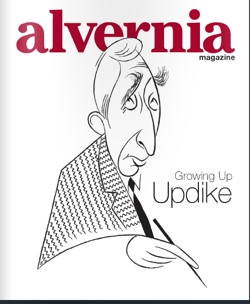 David Updike, the current John Updike Scholar in Residence at Alvernia University, is featured in a new Alvernia Magazine article titled “Growing up Updike” (pp. 20-24).
David Updike, the current John Updike Scholar in Residence at Alvernia University, is featured in a new Alvernia Magazine article titled “Growing up Updike” (pp. 20-24).
In it, he talks about what it’s like being the son of one of America’s most celebrated authors and shares memories of one particular family trip to Pennsylvania, where his father “took us to see his old house in Shillington, but was too shy to knock and ask to go in,” so he “walked us back to the playing field [at the high school behind the house] and the shelter where he used to play roof ball,” David writes.
“Even at an early age I could sense his disappointment that we seemed to underappreciate these places which, for him, held such sweet emotional weight—the memory of childhood, of his being seven, or so, and sprinting out of the side door of his house [at 117 Philadelphia Ave.] to join his friends in the Pennsylvania twilight, to play a final game of roof ball.”
 “It must have been a surprise to my parents, as it was to me, when I started to write short stories, and then odder still, had them accepted by The New Yorker. Photography, not writing, had been my preferred medium, and I knew well that my father had toiled for a decade or so—sending off countless cartoons, and spots, and light verse—before his poems were accepted by The New Yorker.
“It must have been a surprise to my parents, as it was to me, when I started to write short stories, and then odder still, had them accepted by The New Yorker. Photography, not writing, had been my preferred medium, and I knew well that my father had toiled for a decade or so—sending off countless cartoons, and spots, and light verse—before his poems were accepted by The New Yorker.
“I knew that my own success was somehow unjustified—unearned. I need not have worried, for in my mid-twenties things got more difficult, and I was languishing in New York, where I had moved for no very good reason . . . .”

